.
Lapis lazuli is one of the most mysterious and a favorite among crystal healing, mineral collectors, and metaphysical purposes.
Its natural good looks also keep it in high demand in the jewelry trade. We’re going to dive deep into all its aspects today.
History and Lore
Ancient texts often referred to this stone as “sapphire” yet oftentimes they were actually citing lapis.
“Lapis lazuli” literally means “blue stone”. Lapis is Latin for “stone”, hence the word “lapidary” meaning work involving working with stones; engraving, cutting, or polishing. Then “lazuli” originally comes from the Persian word, “azul” meaning “blue”.
This gorgeous and enigmatic stone has been used in countless ways with evidence of mining going as far back as 7000 BCE. Archaeologists have documented its use in many cultures as talismans, jewelry, adorning religious objects, sculptures, and structures.

Arguably the most well-known burial mask of all; King Tut’s burial mask incorporated significant use of Lapis lazuli. Photo credit: Jon Bodsworth [Copyrighted free use]
Egypt’s Love for Lapis
The bluestone has been known to hold major religious as well as royal significance in many parts of the world but probably most notably in Egypt. Egyptologists have also noted lapis lazuli’s frequent use for medicinal purposes as well as in statuary, structures, scarabs, and burial masks for its spiritual and metaphysical uses.
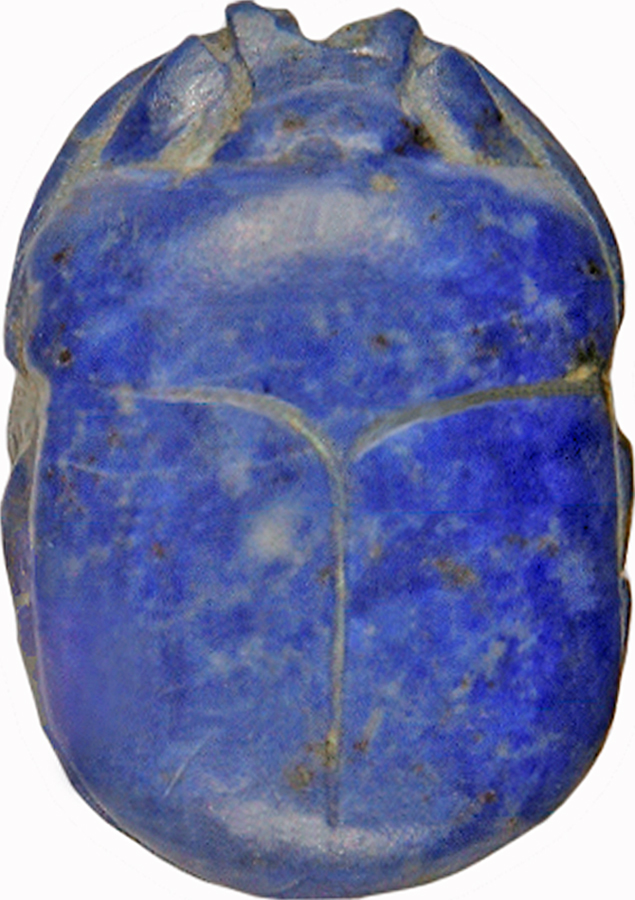
Lapis scarab. Walters Art Museum [Public domain]
Later on, lapis powder was used during the Renaissance period into the 1800s for creating the vivid Ultramarine blue paint.
This paint is very rarely used today due to its scarcity and expense.
Lapis Locales
Afghanistan is THE world’s leading source of high-quality lapis lazuli.
However, this stone can also be found in Chile, Russia, Canada, Argentina, and Pakistan, California, Colorado (Blue Wrinkle), and Arizona. But the quality (and therefore pricing) varies quite a bit.
Metaphysical Uses
Lapis is known for its ability to:
- strengthen our intuition, inner vision, and inner knowing
- powering up confident truth-telling
- protect us on a psychic and spiritual level
- enhancing meditation
- strengthening the clairs (our divining abilities)
- removing blocks to spiritual evolution
You may be wondering if the energy from all the various types of lapis from the different locales also varies. Although I feel that all lapis has a similar energy, I do feel that the energy of the Afghan lappy is definitely more intense…
but you really have to check this out and determine that for yourself.
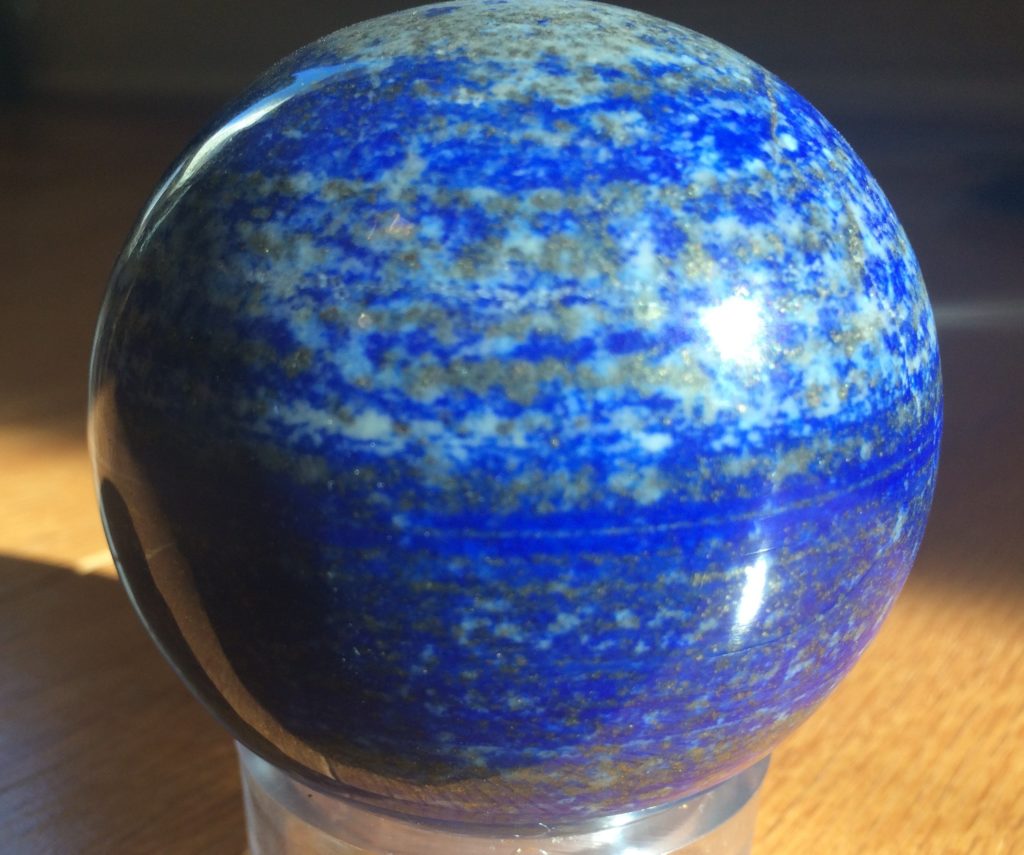
Chakras
This stone is ideal for balancing, strengthening, and awakening the Third Eye chakra while inviting in better visualizations and receiving energy and information from this chakra; including past and parallel life viewing.
It’s also quite powerful for the throat chakra. Please always use caution when using it for this chakra as it may be too intense for some.
Geology
Lapis lazuli is not a mineral.
Instead, it’s a rock.
See, one of the criteria for being a mineral is to have a consistent chemical composition, which lapis doesn’t have. So just like granite, it’s a rock composed of several different minerals.
The inconsistency of exactly which minerals are present in lapis is the very reason why its Mohs Hardness varies so much — so we can’t use that as a method of testing to see if it’s real.
Color Variations
Most lapis from locales other than Afghanistan is usually much less expensive and less “dazzling”.
It has:
- more gray in it
- is more of a dull blue
- and lacks the pyrite flecks
Here’s an example of the “less dazzling” lapis lazuli (my stash from Chile in this photo below). You’ll note there’s no pyrite and there’s a lot of greys (from calcite).
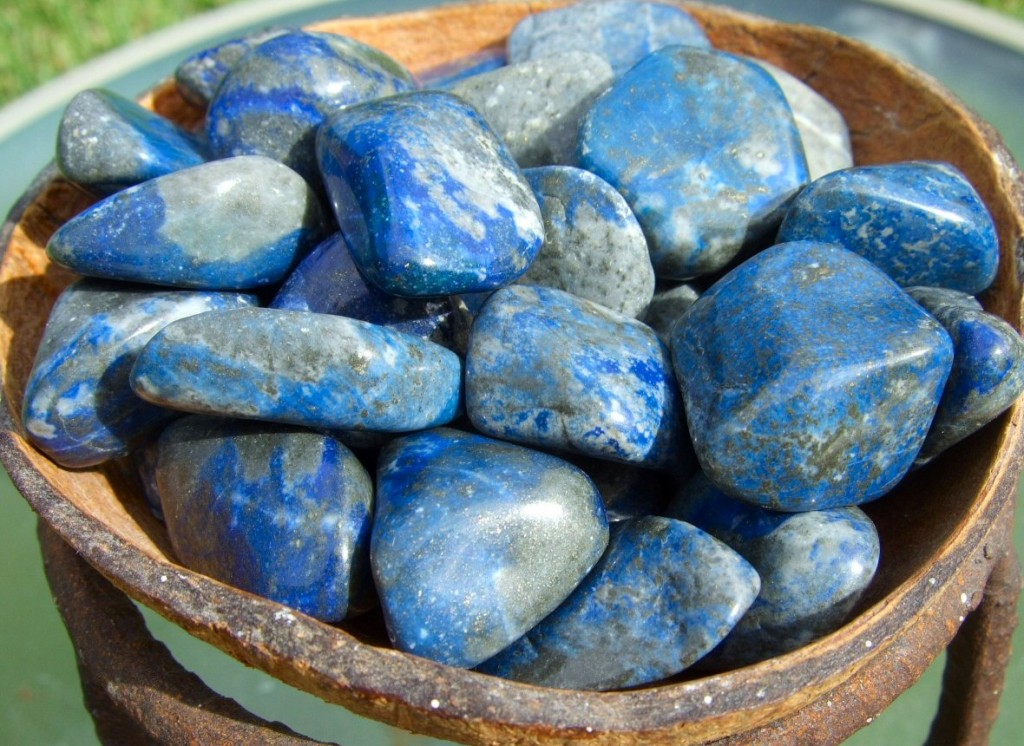
Afghan lapis (in this next photo) has little to no grey and the blue is much deeper and more vibrant —
but also has that characteristic pyrite. Now, too much pyrite may give the stone a slightly greenish hue in some places.
Keep in mind — the deeper and more vibrant the blue (plus the presence of the sparkly pyrite) is the more preferred lapis lazuli, which is just one reason it’s more expensive and a bit harder to come by. We’ll get into the other reason in just a bit.
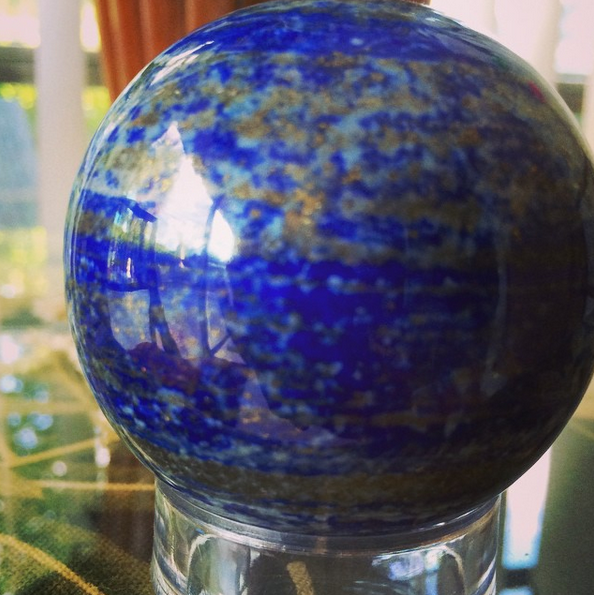
Color Origin
There’s a geological debate on exactly WHERE that deep vibrant almost indigo-dreamy blue color comes from. Most geologists used to agree that the blue came from the main mineral component; lazurite (a blue silicate in the sodalite family).
BUT it seems most geologists have since decided that most of the blue comes instead from the gorgeous mineral haüyne; (also, in the sodalite family).
Geologists also used to say that to technically be called “lapis lazuli,” it had to have a distinctive blue color (which still holds true) but that it also should contain at least 25% blue lazurite. Obviously, this is no longer the case being that lazurite is no longer considered the reason for the color.
Blood Mineral Status
Over the last few years, much controversy surrounding the mining of lapis lazuli has come up.
There’s been a lapis lazuli shortage happening that began trickling into the gem market around 2016.
At that time, I did an investigative blog post to see what was going on.

Afghan Lapis. Photo Credit: Hannes Grobe [CC BY-SA 2.5 (https://creativecommons.org/licenses/by-sa/2.5)]
The Global Witness, a non-governmental agency that exposes natural resource corruption, has also drawn some major attention to the problem and was “calling for the government to ensure publication of mining data, reform mining oversight, and support community monitoring of mining.” They want lapis defined as a blood mineral. To date though. I don’t see that this has been accomplished yet.
What I’m Doing
Personally, I decided several years ago not to purchase ANY Lapis Lazuli (talk about HARD to pass up!!!)… until I hear that things have been restored back to normal there. Sadly, I still haven’t found evidence of that.
When I heard about this issue, I made a decision to alter our required school supplies for my Certified Crystal Header Course to make sure not to include any lapis at all. So, I’m not purchasing any (even if it’s been around in someone’s shop for years) — because that will create a void; a need for the shop owner to get more for someone else. Right?
Listen, I’m not preaching what anyone else should do. Heck, I don’t know what the right solution is! This is just what I’ve decided to do.
Watch Out for Fake Lapis!
Its attractiveness, ease of “fake-ability” and difficulty in recognizing the fakes make lapis A POPULAR one to keep on our “Fakes Short List”.
Soap Box Side Bar: I have a mission to create a well-educated Crystal Family so that we can make well-informed decisions when adding specimens to our sacred collection.
I just want us all to have the knowledge first and then you can make an informed buying decision. If you want a fake in your collection then have it at. No judgment there. I just want you to be able to tell the difference.
As always, the moral of the story here is… Buyer Beware:
-
- Who are you buying from?
- Are they reputable?
- Do they know what they’re talking about?
- Are you doing your own homework?
The best way to protect yourself is through education.
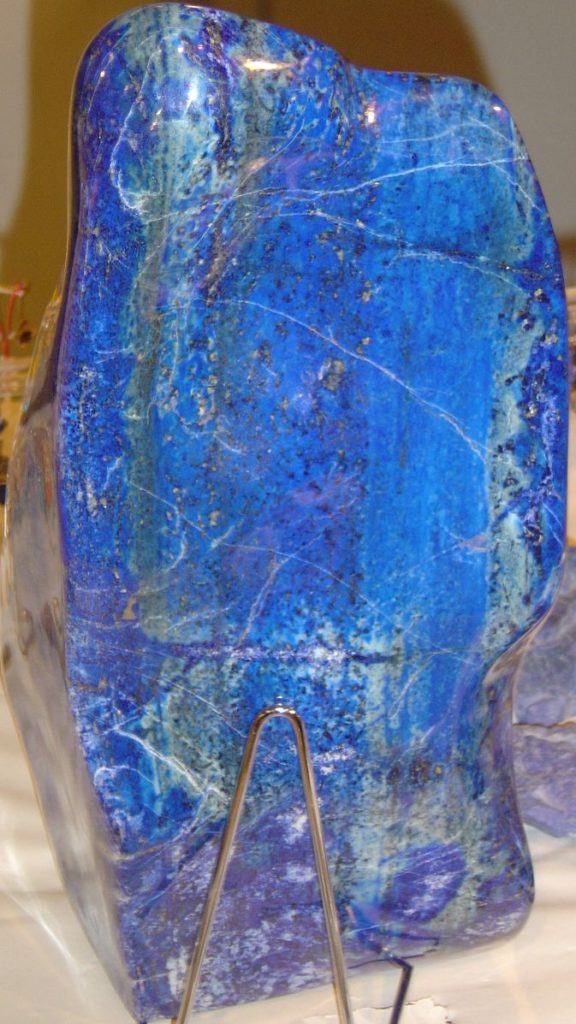
Genuine Lapis Lazuli. Used with permission. (photo credit: fr:User:Luna04 )
The Dye Game
Many times, poor-quality and much less expensive sodalite, calcite, jasper, or white howlite are dyed blue so they can be deceptively passed off as lappy. Sometimes even plastic, resins, or glass (either mixed in with lapis lazuli “powder” to make “reconstituted” lapis or pure) will be sold as the bluestone!
Since it’s porous, lapis itself can be “enhanced” — often wholesalers will put some dye in it to colorize the calcite portion of the stone making it look a more vivid and deeper blue. This practice is actually quite common and I don’t mind it as much as passing something off as lapis when it’s not.
My 9 Tips for Spotting Fake Lapis Lazuli
- Look for areas that are TOO dark blue – (a good giveaway) of overdye. Overdye can also rub off on your fingers. Acetone (nail polish remover) or alcohol can remove some of the dye from a fake but may also damage the stone so tread lightly.
- Sniff for sulfur (rotten egg) odor when cutting for lapidary purposes – that’s a sign of a genuine piece because true lappy always contains the element of sulfur
- Teeth Tap– One way to test if it’s plastic is to tap it on your teeth. Plastic will give a dull tap whereas the “real deal” will make a higher-pitched clink.
- Cool to Touch – Real lapis will feel cooler to the touch when compared to fake plastics.
- Meltability – Plastics can melt or catch on fire too so hold it up to a flame (carefully!)
- Too Perfect – If it’s very uniform it may be reconstituted (which is not technically fake but completely altered by man). Or it may be plain ole’ plastic, resin, or glass
- Too much white – Lapis can be easily confused with sodalite but will have much less white calcite, also too much white is a sign of a lower quality lapis — if it’s too heavy on the white then pass. If you know how to do a streak test, sodalite will have a white streak whereas lapis will have a slightly light blue streak
- Too much grey – If it has a lot of grey in it, it may, again, be sodalite or a sign of a lower quality lapis; streak test!
- Cheap Price – this is usually an indicator of a fake. If it’s too cheap; too good to be true — most likely is.
Remember… the inconsistency of lapis is the very reason why its Mohs Hardness varies so much so, unfortunately, we can’t use that as a method of testing to see if it’s real.
Thanks for joining me for this spotlight on Lapis Lazuli! Let me know in the comments below; what’s your favorite way to work with Lapis Lazuli?
Check out my UPDATED Lapis Lazuli blog post here.
Crystal Blessings,




This video on Lapis Lazuli has been removed. I just missed it. Are you putting this back up??
Thank you
Susie, it’s right at the top of this blog post. Do you see it?
Thank you for this information as Lapis is one of my favourite crystals so I will be careful when I go out looking for crystal gifts for close friends!
Thank you for sharing this information. I love learning about gemstones and rocks!
Awesome…What a splendid work…Your article is full of information about gemstones I really appreciate your work.
I Have a small piece (genuine) that I bought about 28 years ago. Thanks for confirming its real.
Thank you so much for this full packed info. Appreciate it a lot!
Lapis Lazuli is so pretty. Thanks for giving the info. on this. The more info. the better.